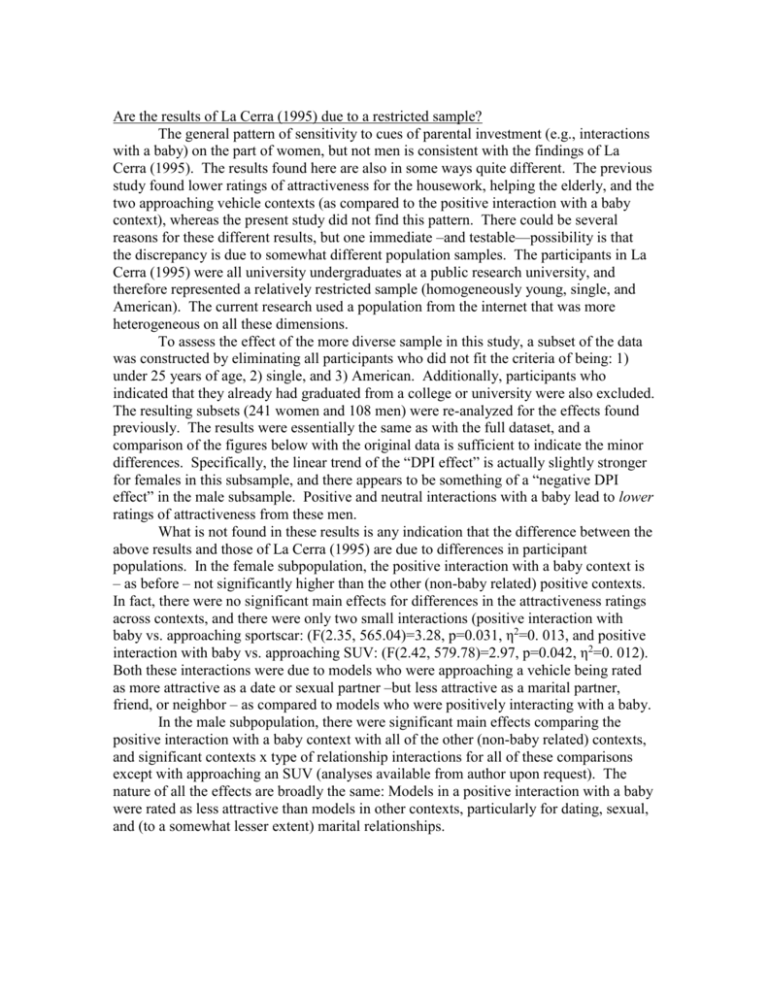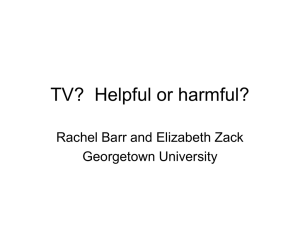
Are the results of La Cerra (1995) due to a restricted sample?
The general pattern of sensitivity to cues of parental investment (e.g., interactions
with a baby) on the part of women, but not men is consistent with the findings of La
Cerra (1995). The results found here are also in some ways quite different. The previous
study found lower ratings of attractiveness for the housework, helping the elderly, and the
two approaching vehicle contexts (as compared to the positive interaction with a baby
context), whereas the present study did not find this pattern. There could be several
reasons for these different results, but one immediate –and testable—possibility is that
the discrepancy is due to somewhat different population samples. The participants in La
Cerra (1995) were all university undergraduates at a public research university, and
therefore represented a relatively restricted sample (homogeneously young, single, and
American). The current research used a population from the internet that was more
heterogeneous on all these dimensions.
To assess the effect of the more diverse sample in this study, a subset of the data
was constructed by eliminating all participants who did not fit the criteria of being: 1)
under 25 years of age, 2) single, and 3) American. Additionally, participants who
indicated that they already had graduated from a college or university were also excluded.
The resulting subsets (241 women and 108 men) were re-analyzed for the effects found
previously. The results were essentially the same as with the full dataset, and a
comparison of the figures below with the original data is sufficient to indicate the minor
differences. Specifically, the linear trend of the “DPI effect” is actually slightly stronger
for females in this subsample, and there appears to be something of a “negative DPI
effect” in the male subsample. Positive and neutral interactions with a baby lead to lower
ratings of attractiveness from these men.
What is not found in these results is any indication that the difference between the
above results and those of La Cerra (1995) are due to differences in participant
populations. In the female subpopulation, the positive interaction with a baby context is
– as before – not significantly higher than the other (non-baby related) positive contexts.
In fact, there were no significant main effects for differences in the attractiveness ratings
across contexts, and there were only two small interactions (positive interaction with
baby vs. approaching sportscar: (F(2.35, 565.04)=3.28, p=0.031, η2=0. 013, and positive
interaction with baby vs. approaching SUV: (F(2.42, 579.78)=2.97, p=0.042, η2=0. 012).
Both these interactions were due to models who were approaching a vehicle being rated
as more attractive as a date or sexual partner –but less attractive as a marital partner,
friend, or neighbor – as compared to models who were positively interacting with a baby.
In the male subpopulation, there were significant main effects comparing the
positive interaction with a baby context with all of the other (non-baby related) contexts,
and significant contexts x type of relationship interactions for all of these comparisons
except with approaching an SUV (analyses available from author upon request). The
nature of all the effects are broadly the same: Models in a positive interaction with a baby
were rated as less attractive than models in other contexts, particularly for dating, sexual,
and (to a somewhat lesser extent) marital relationships.
Age, education, marital status, and nationality-restricted sample of women’s and men’s
ratings of attractiveness (controlling for global sex and relationship type differences)
across all the contexts
Ratings of Attractiveness
Figure a: Female ratings of male models
1.5
Pos Baby
Neut Baby
Neg Baby
0.5
-0.5
-1.5
Date
Sex
Marry
Friend
Neighbor
Type of Relationship
Ratings of Attractiveness
Figure b: Male ratings of female models
1.5
Pos Baby
Neut Baby
Neg Baby
0.5
-0.5
-1.5
Date
Sex
Marry
Friend
Type of Relationship
Neighbor









